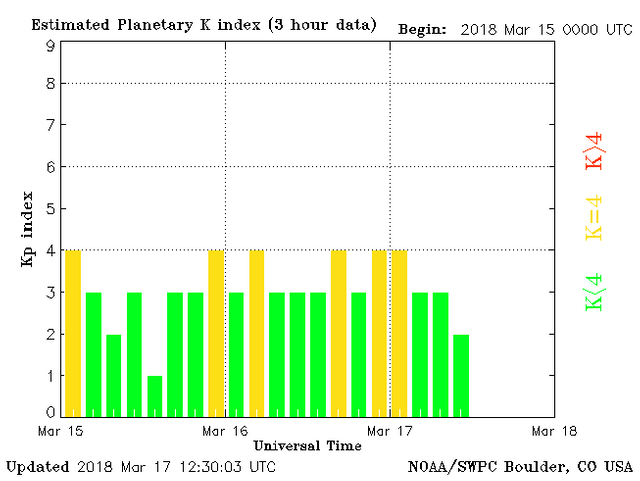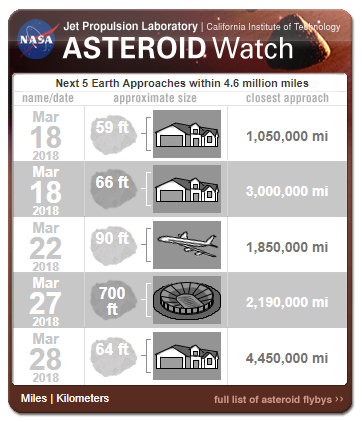Space Weather Daily Update for 17 March, 2018
Rare Aurora, Deadly Hail, Water Below
The last 24 Hours of Earth Facing disc was basically boring. No sunspots, no solar flares and no coronal mass ejection(CME). A small sunspot group did start to appear as it departing the disc. The solar wind has been elevated as we head towards the Spring Equinox, which allows for the Earth to experience more space weather than we really want, but does make for pretty Aurora videos. The Planetary K-index is still in high green levels, reflecting the solar wind activity. The coronal hole that has been departing for the last couple of days is showing to still be expanding across the disc, which will most likely lead to more large earthquakes.
Earthquakes and volcanoes of note
- 5.5 magnitude earthquake on the Southern Mid-Atlantic Ridge
- 5.0 magnitude earthquake near the Balleny Islands region
- 4.7 magnitude earthquake Southeast of Easter Island
- 4.5 magnitude earthquake near Uribia, La Guajira, Colombia
Space Objects
No new Near-Earth Objects(NEO) added to the database
Other News
- Ice-VII inclusions in diamonds: Evidence for aqueous fluid in Earth’s deep mantle. "Water-rich regions in Earth’s deeper mantle are suspected to play a key role in the global water budget and the mobility of heat-generating elements."
- FRB microstructure revealed by the real-time detection of FRB170827.
We report a new Fast Radio Burst (FRB) discovered in real-time as part of the UTMOST project at the Molonglo Observatory Synthesis Radio Telescope (MOST). FRB170827 is the first detected with our low-latency ( <24 s), machine-learning-based FRB detection system.
It's a TRAP!
~ Ben Davidson (Suspicious0bservers ) at SuspiciousObservers.org
I am not affiliated with Ben Davidson or his work. I am a subscriber to SuspiciousObservers YouTube channel.
- Space Weather News
- Quake Watch
- Earth Changes - mobile app
- STARWATER
Space Weather


Source: http://www.swpc.noaa.gov/products/planetary-k-index
Asteroid Watch

Average distance between Earth and the moon is about 239,000 miles (385,000 kilometers).Source: https://www.jpl.nasa.gov/asteroidwatch/
| Object | Flyby Date | AU distance | Approximate Sixe |
|---|---|---|---|
| (2018 ET1) | 2018-Mar-18 | 0.01124 | 14 m - 31 m |
| (2018 EC1) | 2018-Mar-18 | 0.03223 | 16 m - 35 m |
| (2018 EV1) | 2018-Mar-22 | 0.01986 | 22 m - 48 m |
| (2018 DH1) | 2018-Mar-27 | 0.02357 | 170 m - 380 m |
| (2016 SR2) | 2018-Mar-28 | 0.04791 | 15 m - 34 m |
Close Approach Database
Source: https://cneos.jpl.nasa.gov/ca/
Let the positive energy sing!
More Power to the Minnows!!

Trading on Bittrex and Binance
Claim Your Stake with a Stake Box
HODLin’
Stellar Lumen(XLM) -- Cardano (ADA) -- Digibyte(DGB)
Get your old school text-based gaming on.


